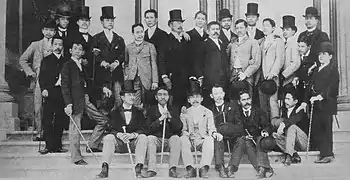Spanish people of Filipino ancestry
There are many Spanish people of Filipino ancestry, consisting of the descendants of early migrants from the Philippines to Spain, as well as more recent migrants. Some 200,000 Filipinos are estimated to live in Spain,[1] including 37,000 expatriates from the Philippines living in Spain who do not hold Spanish citizenship.
| Total population | |
|---|---|
| 200,000 (2018)[1] Including an estimated 37,000 people with Filipino citizenship only.[2] | |
| Regions with significant populations | |
| Madrid, Barcelona, Málaga and other urban areas The following numbers (from 2021) represent Filipinos in Spain with Filipino citizenship only.[2] | |
| 16,119 (43.17%) | |
| 11,765 (31.51%) | |
| 2,857 (7.65%) | |
| 2,214 (5.93%) | |
| 1,911 (5.12%) | |
| Languages | |
| Castilian Spanish, Philippine Spanish, regional languages of Spain, English, Filipino and/or other Philippine languages | |
| Religion | |
| Mainly Roman Catholicism, some Protestantism and Islam | |
| Related ethnic groups | |
| Other Filipino people and Spanish people individually | |
Filipino migration to Spain has a long history owing to the Philippines being a Spanish possession for much of its history. While Filipino migration within the Spanish Empire was recorded as early as the 16th century, the first Filipino migrants to metropolitan Spain only began arriving in the late 19th century, forming the country's first and oldest Asian immigrant community, although mass migration would not begin until after Philippine independence. Rapid growth in the community since the 1990s has led to Filipinos in Spain forming one of the largest Filipino diaspora communities in Europe.[3]
Historically one of the country's largest Asian minority groups, today Filipinos rank alongside the Chinese and Pakistanis as among one of Spain's three largest Asian minorities.[4] Most Filipinos in Spain overwhelmingly live in the country's two largest cities, Madrid and Barcelona, with smaller communities present in the rest of the country.
History

The first Filipino settlements in Spain date back to the Spanish colonial period of the Philippines between the 16th and 19th century, although most migration from the Philippines to Spain during this period was to the territories of New Spain, where some 3,600 Asians – mostly Filipinos working on the Manila galleons – migrated to between 1565 and 1700.[5]
Migration to metropolitan Spain from the Philippines was practically non-existent for most of the islands' history under Spanish rule,[6] and didn't begin until the end of the 19th century, when the ilustrados, largely from the middle and upper classes, pursued higher education in Spain.[7] By 1880, some 200 Filipinos, including figures such as José Rizal, were living in Spain to pursue higher education, and although they would form Spain's first and oldest Asian immigrant community,[8] many from this group of migrants would return to the Philippines later on in the wake of the Philippine Revolution.[9] Intermittent migration from this period would continue until the early American colonial period when, starting in the 1920s, economic ties between the Philippines and Spain began to be cut in favor of ties with the United States.[10] By the end of the Spanish Civil War, the Filipino community in Spain was estimated to only number at least 200 people.[11]
Contemporary migration to Spain from the Philippines can be broken down into three waves. The first wave of Filipino migration to Spain consisted primarily of Spanish Filipinos and Spaniards in the Philippines who would leave the country after World War II and in the first years after Philippine independence, beginning with some 300 survivors of the Battle of Manila who left the country onboard two ships, the Plus Ultra and the Halekala.[12] Contemporary economic migration did not begin until the 1960s, when a second wave of migrants moved to Spain as domestic workers, largely women in the employ of Spanish businessmen who in that period decided to return to Spain from the Philippines while bringing their domestic helpers along with them.[9] This was followed by a third wave that began in the 1980s, whose members replaced those of the second wave who had since migrated to other countries, particularly the United States and Canada.[6] The later two waves of migration significantly changed the makeup of the Filipino community in Spain, as later arrivals were typically of a lower social class and had few (if any) ties to Spain compared to the existing community established by the smaller first wave of migrants, whose members were wealthier and had more ties to Spain.[13]
Overseas Filipino Workers were not formally deployed to Spain in large numbers until 2006, when the two countries signed a memorandum of understanding on the entry of skilled labor, leading to the deployment of some 160 Filipino nurses and caregivers to nursing homes throughout Spain.[14] The agreement, which would allow for up to 200,000 Filipino workers to enter Spain,[14] also paved the way for other highly-skilled professionals like engineers and doctors to migrate to the country.[15] This led to significant growth in the community: while there were only 25,000 Filipinos in Spain in 1992,[16] this grew to over 40,000 by 2006,[14] and to over 50,000 by the following year.[15]
Demographics

Population and distribution
There are over 200,000 Filipinos in Spain as of 2018,[1] and the Instituto Nacional de Estadística estimates that there are 53,388 persons in Spain who were born in the Philippines,[17] including 37,355 Filipino citizens registered in municipal registers (padrón municipal de habitantes) throughout Spain, as of 2021.[2] While Filipinos in Spain come from various parts of the Philippines, most originate from Luzon, with Tagalogs, Ilocanos and Bicolanos being the most numerous.[18] As Filipinos can apply for citizenship after only two years' residence in Spain,[19] some 2,000 Filipinos acquire Spanish nationality every year, a phenomenon which began in the 1990s,[20] and it is believed that the actual number of Filipinos in Spain – including those who have since become Spanish citizens – could be as high as 300,000 or more.[21]
Some three quarters of all Filipino migration to Spain is to the Community of Madrid and Catalonia, which are home to the oldest Filipino communities in Spain,[22] and a distribution that is shared with Peruvians and Dominicans as communities that are particularly concentrated in these two autonomous communities.[23] Smaller populations of Filipinos are also found in Spain's other autonomous communities, with the largest concentrations found in Andalusia, the Balearic Islands and the Canary Islands.[24] For historical reasons, most Filipino migrants to Spain were working-age women,[25] which is still reflected in the contemporary makeup of the community.[26]
Major Filipino enclaves are found in the cities of Madrid and Barcelona, where most Filipinos in Spain live.[7] In Madrid, most Filipinos live in the district of Tetuán,[27] forming the largest immigrant group in four of the district's six neighborhoods, as well as in four other neighborhoods in other parts of the city, including the neighborhood of El Viso in neighboring Chamartín, which is home to the Philippine Embassy in Madrid.[28] Meanwhile, about half of all Filipinos living in Barcelona live in the district of Ciutat Vella, with significant populations also found in the Eixample and Sants-Montjuïc districts.[29] The community is primarily concentrated in the northern half of El Raval in Ciutat Vella,[30] which is reportedly home to fifteen percent of all Filipino citizens in Spain and is also home to most of the local community's cultural and social institutions.[31] In Andalusia, a more diffuse community is found in Málaga, with some 5,000 Filipinos residing in the eponymous province,[32] including a significant community in Marbella,[33] and a smaller community of some 300 in Seville.[34] Beyond the peninsula in the Balearic Islands, some 2,500 Filipinos live on the islands of Ibiza and Formentera,[35] and another 2,000 on Mallorca,[36] while in the Canaries, communities are found in Las Palmas, where over 1,000 Filipinos live,[37] and on the island of Tenerife.[38]
Employment
Before 2006, Filipinos who went to Spain for work typically did so as domestic helpers,[15] and most Filipinos in Spain still work either as domestic helpers or in adjacent service industries,[21] including in the restaurant industry,[39] as hotel workers,[30] and as house cleaners.[31] Beyond the service sector, Filipinos are also employed as teachers,[37] farm workers in rural Spain,[40] nurses,[41] language assistants,[42] and military personnel.[43] For Filipinos looking to migrate overseas, Spain is seen as an attractive destination due to its robust labor laws and generous pay and employment benefits,[15] as well as the relative ease of obtaining legal residence in the country compared to other countries in Europe.[30]
In recent years, Filipinos in Spain have also begun setting up their own businesses,[44] with a number of Filipino restaurants, bars, bakeries, grocery stores and call shops, among other businesses, setting up shop in Tetuán,[45] El Raval,[46] and Las Palmas,[37] as well as in other parts of the country.[47] Wealthy Filipinos have also spurred demand for Spain's immigrant investor program.[48]
Community issues
Education
Although a significant proportion of Filipinos who migrate to Spain are highly educated, many are underemployed due to difficulties in getting their credentials recognized in Spain.[49] Filipinos who want to exercise their profession in Spain are deterred by the high cost of homologation and the need to return to school despite already being certified in the Philippines, leaving them unable to find employment and forcing them to take lower-skilled jobs.[50] Nurses, for example, have only been able to practice their profession as a result of the COVID-19 pandemic in Spain after working other jobs, where otherwise they wouldn't have been able to do so.[41]
Language
New Filipino migrants to Spain are often not fluent in Spanish nor, if such is the case, the regional language of their autonomous community. In a 2020 survey, more than half of all surveyed Filipino migrants on Ibiza reported not being fluent in either Spanish or Catalan, although they were generally fluent in English, Filipino and/or other languages of the Philippines.[51] While a lack of Spanish fluency has led to many Filipinos being underemployed,[49] English fluency is a reported advantage for the community, as Filipinos often find work in the employ of other non-Spanish speaking foreigners.[51]
Fluency in Spanish and regional languages increases with the children of migrants who are born in Spain, as they learn those languages in school along with English and other foreign languages. While they become native Spanish speakers, unlike their parents, it often comes at the expense of learning Filipino and other Philippine languages.[51]
Notable people
Filipinos in Spain
- Carlos Celdran, tour guide and activist
- Félix Resurrección Hidalgo, artist
- Antonio and Juan Luna, revolutionaries
- Antonio "Júnior" Morales, singer
- Kitchie Nadal, singer
- Isabel Preysler, socialite
- José Rizal, national hero of the Philippines
- Geraldine Roman, journalist and Philippine politician
- Fernando Zóbel de Ayala y Montojo, artist
Spanish people of Filipino descent
- Paulino Alcántara, footballer
- Luis Eduardo Aute, musician and film director
- Marcelo Azcárraga Palmero, thirteenth Prime Minister of Spain
- Shaila Dúrcal, singer
- Ángel and Juan Luis Guirado, footballers
- Julio and Enrique Iglesias, singers
- Alexandra Masangkay, actress
- Jorge Moragas, Spanish politician
- Carli de Murga, footballer
- Javier Patiño, footballer
See also
References
- Masigan, Andrew J. (June 24, 2018). "Economic diplomacy is as important as OFW diplomacy". BusinessWorld. Retrieved September 9, 2022.
- "Filipinos en España. Padrón municipal 2022, cifras de población" [Filipinos in Spain. 2022 municipal register population figures.]. EPA.com.es (in Spanish). Retrieved September 6, 2022.
- Tan, Michael L. (August 24, 2016). "'Euro Pinoys'". Philippine Daily Inquirer. Retrieved October 17, 2022.
- Beltrán Antolín & Sáiz López 2002, p. 21.
- Oropeza 2016, p. 349-350.
- González Enriquez & Martínez Romera 2016, p. 22.
- Castellví Laucamp, Luis (June 12, 2019). "Filipinas en España" [The Philippines in Spain]. El Español (in Spanish). Retrieved December 21, 2021.
- Beltrán Antolín & Sáiz López 2002, p. 15.
- Castañeda 2007, p. 283.
- Elizalde Pérez-Grueso 1998, p. 5-6.
- Beltrán Antolín & Sáiz López 2002, p. 17.
- Rodao 2007, p. 424.
- Molina 1992, p. 100-101.
- Calica, Aurea (June 29, 2006). "Spain starts hiring RP health workers". The Philippine Star. Retrieved January 22, 2022.
- Sy, Marvin (December 4, 2007). "RP back to normal, GMA assures Pinoys in Spain". The Philippine Star. Retrieved January 22, 2022.
- "Filipino Migration to Europe: Country Profiles". Philippine-European Solidarity Centre. Archived from the original on November 28, 1999. Retrieved January 22, 2022.
- "Población (españoles/extranjeros) por país de nacimiento y sexo" [Population (Spaniards/foreigners) by country of birth and sex] (in Spanish). Instituto Nacional de Estadística. Retrieved September 6, 2022.
- Castañeda 2007, p. 285.
- Gutierrez, Pia (March 27, 2014). "Spain clarifies legislation offering citizenship". ABS-CBN News and Current Affairs. Retrieved January 24, 2022.
- Alzona, Rodel (December 20, 2015). "Spaniards have high regard for Filipinos living in their country". BusinessMirror. Retrieved October 18, 2021.
- Uy, Veronica (March 25, 2009). "OFWs still welcome in Spain". Philippine Daily Inquirer. Archived from the original on March 27, 2009. Retrieved March 25, 2009.
- Beltrán Antolín & Sáiz López 2002, p. 16.
- Actis, Ángel de Prada & Pereda 2003, p. 29.
- Actis, Ángel de Prada & Pereda 1999, p. 75.
- Beltrán Antolín & Sáiz López 2002, p. 25-26.
- Rogales Castillo 2021, p. 85.
- Viejo, Manuel (November 5, 2021). "Peregrinación de filipinos a la Puerta del Sol para comer pollo frito" [The Filipinos' pilgrimage to the Puerta del Sol to eat fried chicken]. El País (in Spanish). Retrieved January 22, 2022.
- "Los chinos ya son los extranjeros mayoritarios en 19 barrios madrileños y los filipinos en 8" [The Chinese are now the largest group of foreigners in 19 Madrid neighborhoods and the Filipinos in 8]. La Vanguardia (in Spanish). April 29, 2018. Retrieved October 15, 2021.
- "Perfil de los colectivos más numerosos en Barcelona. 2016-2020: Nacionalidad filipina" [Profile of the most numerous populations in Barcelona, 2016-2020: Filipino nationals] (in Spanish). City Council of Barcelona. Retrieved December 21, 2021.
- Márquez Daniel, Carlos (November 20, 2020). "Filipinos: la comunidad silente de Barcelona" [Filipinos: the silent community of Barcelona]. El Periódico de Catalunya (in Spanish). Retrieved October 15, 2021.
- Pareja, Pol; Calvó, Sònia (May 30, 2020). "220 menús diarios y lo que haga falta: la discreta red de ayuda entre los filipinos para evitar el colapso de la comunidad" [220 meals of the day and whatever is needed: the discreet help network between Filipinos to avert community collapse]. elDiario.es (in Spanish). Retrieved October 15, 2021.
- Escalera, Ángel (April 24, 2016). "El corazón de Filipinas, en Málaga" [The heart of the Philippines, in Málaga]. Diario Sur (in Spanish). Retrieved October 24, 2021.
- Vidal, Marcel (February 15, 2020). "El Ayuntamiento se reúne con comunidades extranjeras de Marbella" [City Hall reunites with Marbella's foreign communities]. La Opinión de Málaga (in Spanish). Retrieved October 17, 2022.
- Balcos, Olivia (May 16, 2019). "Tita Del y el nacimiento de una comunidad" [Tita Del and the birth of a community]. más+menos (in Spanish). CIEE Seville. Retrieved February 13, 2023.
- Turel, Jesús (July 28, 2021). "«No he oído a nadie en Ibiza que haya tenido ni un solo problema con los filipinos»" ["I have not heard of anyone on Ibiza who has had a single problem with Filipinos"]. Periódico de Ibiza (in Spanish). Retrieved January 24, 2022.
- Adrover, Miquel (November 13, 2011). "Unos 800 filipinos de Balears renuevan su documentación en un convento" [Some 800 Filipinos in the Balearic Islands renew their residence documents in a convent]. Diario de Mallorca (in Spanish). Retrieved January 24, 2022.
- Vego, Herbert (June 1, 2017). "PEOPLE POWWOW | A growing Filipino community in Las Palmas". Panay News. Retrieved October 17, 2022.
- Cabrera, Javier (August 6, 2019). "De los llantos de sus padres a la llegada se pasó al crecimiento y éxito de sus hijos" [From the tears of their parents upon arrival, they've moved on to the growth and success of their children]. Diario de Avisos (in Spanish). Retrieved October 17, 2022.
- Díaz Murillo, Javier (June 3, 2016). "Los restaurantes de Madrid se 'rifan' a los cocineros filipinos" [Madrid's restaurants "draw lots" on Filipino cooks]. El Mundo (in Spanish). Retrieved January 24, 2022.
- Turel, Jesús (March 31, 2008). "12.000 kilómetros para coger fresas" [12,000 kilometers to pick strawberries]. El País (in Spanish). Retrieved January 24, 2022.
- Sotelo Aboy, Sandra (April 10, 2020). "Babysitters no more, Filipino nurses in Spain find place on COVID-19 frontlines". ABS-CBN News and Current Affairs. Retrieved January 24, 2022.
- Peñalosa, Gelene (October 14, 2021). "8 Interesting observations from the perspective of a Filipina living in Spain". Philippine Daily Inquirer. Retrieved January 24, 2022.
- Buenafe, Danny (July 2, 2009). "Filipino Among Royal Guards of King of Spain". ABS-CBN News and Current Affairs. Archived from the original on August 8, 2011. Retrieved July 2, 2009.
- Sánchez, Cristina (March 2, 2011). "AFIMA promueve el emprendimiento entre los inmigrantes" [AFIMA promotes entrepreneurship among immigrants]. Tetuán 30 Días (in Spanish). Retrieved January 24, 2022.
- Sánchez, Cristina (October 2017). "Sonrisas con sabor a coco" [Smiles with a taste of coconut] (PDF). Tetuán 30 Días (in Spanish). p. 13. Retrieved January 24, 2022.
- Crespo, Adrián (April 26, 2016). "Así salen de fiesta los jóvenes filipinos de Barcelona" [This is how young Filipinos in Barcelona party]. Vice (in Spanish). Retrieved March 6, 2022.
- Portabales, Pablo (November 15, 2021). "El filipino que arrasa en A Coruña" [The Filipino who triumphed in A Coruña]. La Voz de Galicia (in Spanish). Retrieved November 23, 2022.
- "Unli access to Europe: Filipinos snapping up properties in Spain, Portugal for Golden Visa". Bilyonaryo. January 16, 2022. Retrieved January 24, 2022.
- González Enriquez & Martínez Romera 2016, p. 25.
- Malig, Kaela (June 3, 2020). "Pinay in Spain finally becomes nurse after 9 years of waiting, only to test positive for COVID-19 after". GMA News and Public Affairs. Retrieved January 24, 2022.
- Rogales Castillo 2021, p. 84.
Bibliography
- Actis, Walter; Ángel de Prada, Miguel; Pereda, Carlos (1999). Inmigración y trabajo en España. Trabajadores inmigrantes en el sector de la hostelería [Immigration and work in Spain: immigrant workers in the hospitality sector] (PDF) (Report) (in Spanish). Ministry of Labour of Spain. ISBN 84-8446-001-0. Retrieved October 17, 2022.
- Actis, Walter; Ángel de Prada, Miguel; Pereda, Carlos (2003). "La sociedad española y la inmigración extranjera" [Spanish society and foreign immigration] (PDF). Papeles de economía española (in Spanish). Fundación de las Cajas de Ahorros (98). ISSN 0210-9107. Retrieved October 17, 2022.
- Beltrán Antolín, Joaquín; Sáiz López, Amelia (June 20, 2002). Las comunidades asiáticas en España [Asian communities in Spain] (PDF) (Report). Documentos CIDOB: Relaciones España-Asia (in Spanish). Barcelona Centre for International Affairs. Retrieved October 21, 2022.
- Castañeda, Roel (2007). "Filipinos in Spain". In Mongaya Hoegsholm, Filomenita (ed.). In de olde worlde: views of Filipino migrants in Europe. Quezon City: Philippine Social Science Council. pp. 283–289. ISBN 978-971-8514-29-0.
- Elizalde Pérez-Grueso, María Dolores (December 1998). Historia Económica de Filipinas durante la etapa colonial española. Un estudio bibliográfico [Economic history of the Philippines during the Spanish colonial period: a bibliographical study] (PDF) (Report) (in Spanish). Fundación SEPI. Retrieved December 21, 2021.
- González Enriquez, Carmen; Martínez Romera, José Pablo (May 10, 2016). La movilidad transnacional de los migrantes en España [The transnational mobility of migrants in Spain] (PDF) (Report) (in Spanish). Elcano Royal Institute. Retrieved December 21, 2021.
- Molina, Carmen (Spring 1992). "Filipino Migrants in Spain". Philippine Studies. Ateneo de Manila University. 40 (1): 99–110. ISSN 2244-1093. Retrieved January 24, 2022 – via JSTOR.
- Oropeza, Déborah (2016). "La migración asiática libre al centro del virreinato novohispano, 1565-1700" [The Migration of Free Asians to the Central Region of the Vice-Royalty of New Spain, 1565-1700]. Relaciones Estudios de Historia y Sociedad (in Spanish). El Colegio de Michoacán. 37 (137): 347–363. doi:10.24901/rehs.v37i147.181. ISSN 0185-3929. Retrieved December 21, 2021.
- Rodao, Florentino (2007). La Comunidad Española en Filipinas, 1935-1939 [The Spanish Community in the Philippines, 1935-1939] (PDF) (PhD) (in Spanish). University of Tokyo. ISBN 978-84-617-0848-2. Retrieved December 20, 2021.
- Rogales Castillo, Jenilyn (2021). "Un acercamiento a la comunidad filipina de Ibiza" [An approach to the Filipino community of Ibiza] (PDF). Turística. Papers de turisme (in Spanish). University of the Balearic Islands. 3 (1): 77–91. ISSN 2695-5334. Retrieved October 15, 2022.
External links
- EAMiSS – Equip d'Atenció i Mediació Intercultural i Sociosanitari, a Filipino social welfare organization based in Barcelona
- Asociación Cultural Galeón de Manila, a Spanish Filipino cultural organization based in Madrid





